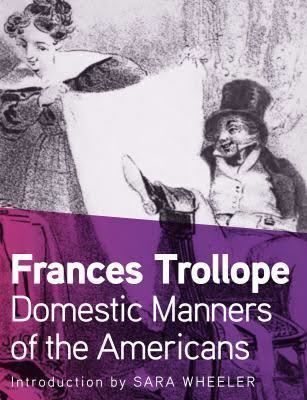7.2 /10 1 Votes7.2
Country United Kingdom Publication date 1832 | 3.6/5 Goodreads Language English Originally published 1832 | |||||||||||||||||||||||||||||||||
 | ||||||||||||||||||||||||||||||||||
Pages c.200 pp (May change depending on the publisher and the size of the text) Similar Frances Milton Trollope books, Non-fiction books | ||||||||||||||||||||||||||||||||||
Domestic manners of the americans
Domestic Manners of the Americans is an 1832 travel book by Frances Trollope, which follows her travels through America and her residence in Cincinnati, at the time still a frontier town. The text now resides in the public domain.
Contents
Context
Frances Trollope traveled to America with her son Henry, "having been partly instigated by the social and communistic ideas of a lady whom I well remember, a certain Miss Wright, who was, I think, the first of the American female lecturers" (Anthony Trollope, An Autobiography). She briefly stayed at the Nashoba Commune, a utopian settlement for ex-slaves which Wright had set up in Tennessee, where she was dismayed by the primitive conditions.
Content
The book created a sensation on both sides of the Atlantic, as Frances Trollope had a caustic view of the Americans and found America strongly lacking in manners and learning. She was appalled by America's egalitarian middle-class and by the influence of evangelicalism that was emerging during the Second Great Awakening. Trollope was also disgusted by slavery, of which she saw relatively little as she stayed in the South only briefly, and by the popularity of tobacco chewing, and the consequent spitting, even on carpets.
Her views were understandable for a number of reasons. It had been only 15 years since the United Kingdom was at war with the United States and the earlier American Revolutionary War was still remembered; as her own views on church, politics and social values were overtly conservative, she did not feel at ease with much in American religion, government and culture; and while in America she was unhappy as a result of financial and marital difficulties.
Final analysis of the USA
After enjoying much of the natural beauty and abundance of the land, the friendliness and kindness of many people she met and the dramatic material advances, her overall impression was not favourable. At the end of the book, she tried to summarise what she found wrong in the American character:
A single word indicative of doubt, that any thing, or every thing, in that country is not the very best in the world, produces an effect which must be seen and felt to be understood. If the citizens of the United States were indeed the devoted patriots they call themselves, they would surely not thus encrust themselves in the hard, dry, stubborn persuasion, that they are the first and best of the human race, that nothing is to be learnt, but what they are able to teach, and that nothing is worth having, which they do not possess.
Style
Trollope "had no profundity of thought ... but she had a seeing eye and a lively pen". Her descriptions are "never boring: she makes us see the lonely clearings and farms, the huge silent rivers, Niagara, untamed and unvulgarised, the clear bright air ..."
Reaction
The book was both highly controversial and highly successful, selling "like wildfire". It also enabled its author to become a wage-earner and save her family from penury. American author Mark Twain was amused and impressed by Trollope's observations of the Antebellum frontier America he grew up in: "Mrs Trollope was so handsomely cursed and reviled by this nation [for] telling the truth... she was painting a state of things which did not change at once. ... I remember it."
